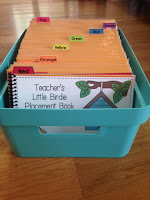Hello all,
Welcome back and thanks for hanging in there. Today is the third installment of the sight word program. You can read about the posts here and here. Today, let’s talk about ORGANIZATION! Which I secretly LOVE!
First off, to get started I gathered a few materials I knew I was going to need for this project, so I got colored copy paper {red, orange, yellow, green, blue, purple, and pink}.
To keep all these goodies organized I got a SUPER cute box from Target. This box fits the 6 X 9 brown kraft envelopes well and I was able to fit all teacher assessment books, dividers, and class sets of all 62 word lists cards. I like to laminate everything so I made sure I had access that too. I made copies of everything I needed and got straight to work.
Putting It Together:
I put the Placement Assessment book first. Yesterday I talked about the assessment books. Click here to read the post. Next, I put the red divider for the pre-primer words. The dividers are included in this kit and would do best printed on card stock and laminated. Then, I placed the Red List Assessment Book and then all of the envelopes that go with the red lists. Yesterday I stated that there are 8 pre-primer lists so you would need 8 envelopes.
To create the envelopes, I printed the labels on red paper and attached them to the brown, kraft envelopes. Before running them through the laminator, I took out the metal clasps. I would highly recommend this step so that you do not ruin your laminator. I printed the pages that I needed onto the color I needed, cut them in half, and put the whole set into the envelope.
Don’t want to go through all of the work of making the envelopes? It is simple, just use paper clips to hold the groups of pages together…and done!
 For the Teacher Assessment Binder for the RtI and progress monitoring documentation, I gathered a 2 in binder and enough dividers for the amount of students in my class and printed the binder pages.
For the Teacher Assessment Binder for the RtI and progress monitoring documentation, I gathered a 2 in binder and enough dividers for the amount of students in my class and printed the binder pages. 
Is all of this organizing getting you excited about this unit yet? No too much longer until I have the unit complete and available on Teachers Pay Teachers. Tomorrow I will be posting about how to use this unit in your classroom throughout the day as we explore the word wall and centers.
Speaking of centers...here is the center activity of the day.
This center activity is a class favorite!!! It is called Flip, Compare, and Read. To create this game, get an egg holder {I happen to find this one during an Easter sale :0) YAY!}, 2 colorful buttons, and a set of sight word cards. I wrote numbers inside of the egg spots. The kids flip their buttons at the same time and compare their numbers. The person with the largest number get to pick a card and read the card. If the word is read properly, that student gets to keep the card. If it is not read properly, and the partner can read the word, the partner gets to put the card in his/her pile. The student with the most word cards wins the game. Get your game card here.

Happy organizing,
Coconut Cutie






















